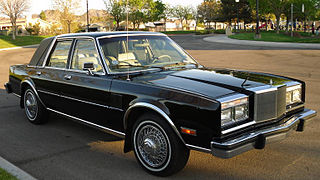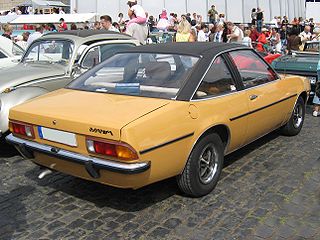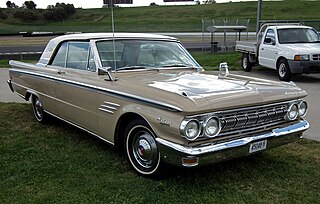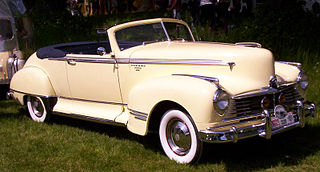
The Ford Country Squire is a series of full-size station wagons that were assembled by American automaker Ford. Positioned as the top-level station wagon of the Ford division, the Country Squire was distinguished by woodgrain bodyside trim. From 1950 through the 1991 model years, eight generations of the Country Squire were produced. Following the discontinuation of Edsel Bermuda, Mercury marketed the Mercury Colony Park as a divisional counterpart of the Country Squire, sharing bodywork and trim while the Mercury was not available with a six cylinder engine and was more expensive due to the optional equipment on the Ford that was standard on the Mercury.

The Oldsmobile 98 is the full-size flagship model of Oldsmobile that was produced from 1940 until 1942, and then from 1946 to 1996. The name – reflecting a "Series 90" fitted with an 8-cylinder engine – first appeared in 1941 and was used again after American consumer automobile production resumed post-World War II. It was, as it would remain, the division's top-of-the-line model, with lesser Oldsmobiles having lower numbers such as the A-body 66 and 68, and the B-body 76 and 78. The Series 60 was retired in 1949, the same year the Oldsmobile 78 was replaced by the 88. The Oldsmobile 76 was retired after 1950. This left the two remaining number-names to carry on into the 1990s as the bread and butter of the full-size Oldsmobile lineup until the Eighty Eight-based Regency replaced the 98 in 1997.

The Chrysler New Yorker is an automobile model produced by Chrysler from 1940 until 1996, serving for several decades as either the brand's flagship model or as a junior sedan to the Chrysler Imperial, the latter during the years in which the Imperial name was used within the Chrysler lineup rather than as a standalone brand.

The Chrysler Fifth Avenue was a trim level/option package or model name used by Chrysler for its larger sedans from 1979 to 1993. The Fifth Avenue name was no longer used after 1993 when Chrysler introduced its new LH-platform New Yorker and similar LHS. The title "Fifth Avenue" references a street in New York City which contains many upscale shops and cultural attractions. The Chrysler Building is two blocks east of Fifth Avenue.

Vinyl roof refers to a vinyl covering for an automobile's top.

The Cadillac Calais is an automobile produced by Cadillac from 1965 to 1976. The Division renamed its entry-level Series 62 as the "Calais" in 1965, after the French port city, derived from Calais in Greek mythology, one of two winged sons of Boreas, god of the North Wind, and Oreithyea. The Calais shared the same styling and mechanics as the better-equipped, more expensive Cadillac de Ville. No convertible model was offered.

Buick Estate is a nameplate that was used by the Buick division of General Motors, denoting its luxury full-size station wagon from 1940 to 1964 and from 1970 to 1996. The Estate nameplate was derived from the term country estate in wealthy suburban areas and estate car, the British term for a station wagon.

The Pontiac Ventura is an automobile model which was produced by Pontiac between 1960 and 1977.

The Chrysler Saratoga is an automobile built by Chrysler. The nameplate was used from 1939 to 1952 and from 1957 to 1960 in the U.S. market, in Canada through 1965, and in Europe from 1989 to 1995. In the beginning, it was introduced as a sport luxury model, using the Straight Eight engine from the Chrysler New Yorker which was more formal, and the Imperial which had graduated to special order limousine.

The Mercury Colony Park is an American luxury full-size station wagon that was marketed by the Mercury division of Ford Motor Company between 1957 and 1991. Distinguished by its simulated wood-grain paneling, the Colony Park was marketed as either the premium-trim or the sole full-size station wagon offering of the division. Following the 1960 demise of Edsel, full-size Mercury vehicles shared bodywork with Ford; the Colony Park served as the counterpart of the Ford Country Squire through 1991.

The Mercury Meteor is an automobile that was produced by Mercury from the 1961 to 1963 model years. Adopting its nameplate from the namesake Ford of Canada brand, the Meteor was introduced as the base-trim full-size Mercury sedan, while the compact Mercury Comet shared a naming convention associated with the ongoing Space Race of the early 1960s. Slotted below the Mercury Monterey, the Meteor was the Mercury counterpart of the Ford Fairlane.

The Henry J is an American automobile built by the Kaiser-Frazer Corporation and named after its chairman, Henry J. Kaiser. Production of six-cylinder models began in their Willow Run factory in Michigan in July 1950, and four-cylinder production started shortly after Labor Day, 1950. The official public introduction was on September 28, 1950, and the car was marketed until 1954.

The Hudson Commodore is an automobile that was produced by the Hudson Motor Car Company of Detroit, Michigan between 1941 and 1952. During its time in production, the Commodore was the largest and most luxurious Hudson model.

The Mercury Monterey is a series of full-size cars that were manufactured and marketed by the Mercury division of Ford from 1950 to 1974. Deriving its name from Monterey Bay, the initial Mercury Monterey served as the top-of-the-line two-door sedan model for 1950 and 1951 to compete with the hardtop models of Oldsmobile and Buick. It came with a vinyl roof covering, upgraded upholstery, and other features. The hardtop was introduced for 1952. During its production, the Monterey would be offered in multiple body styles, ranging from coupes, convertibles, sedans, hardtops, and station wagons.

The Ford Maverick is a compact car manufactured and marketed by Ford for model years 1970–1977 in the United States, originally as a two-door sedan employing a rear-wheel drive platform original to the 1960 Falcon — and subsequently as a four-door sedan on the same platform. The Maverick replaced the Falcon in most of the world, but Australia kept selling and developing the Falcon.

The name Mayfair was applied to the 1951–1953 Packard 250 as a hardtop coupe nameplate built by the Packard Motor Corporation in an attempt to compete in this body style with the Oldsmobile 98 Holiday, Buick Roadmaster Riviera, Lincoln Capri and Chrysler New Yorker Newport hardtop coupes. It was named for the City of Westminster's luxurious district Mayfair in London, England. The coupe body style was also used for a convertible, while the Mayfair model name was exclusive to the hardtop.

The Lincoln EL-Series is a full-size luxury car that was marketed and sold by Lincoln from 1949 to 1951. Replacing the H-Series Lincoln, the postwar model line was the first complete redesign of the Lincoln sedan line since 1936. In line with its predecessor, the EL-Series Lincoln carried only the Lincoln nameplate, using no divisional branding; the Lincoln was slotted below the Lincoln Cosmopolitan within the Lincoln model range.

The Mercury Marauder is an automobile nameplate that was used for three distinct full-size cars produced by the Mercury division of Ford Motor Company. Deriving its name from the most powerful engines available to the Mercury line, the Marauder was marketed as the highest-performance version of the full-size product range.

The Packard Pacific is an automobile manufactured by the Packard Motor Car Company of Detroit, Michigan for the 1954 model year. It replaced the Mayfair and was sold exclusively as a two-door hardtop.

The Mercury Medalist is an automobile which was produced by Mercury for the 1956 model year and was similar to the Ford Customline in market segment.





















